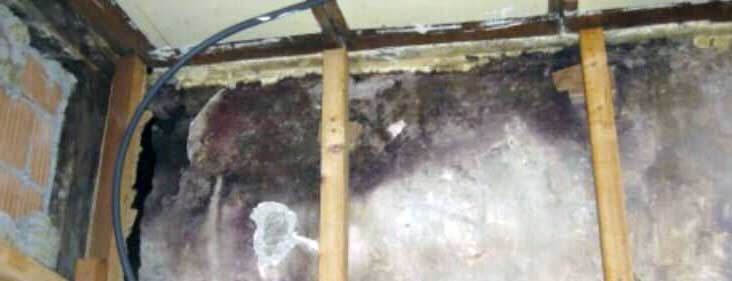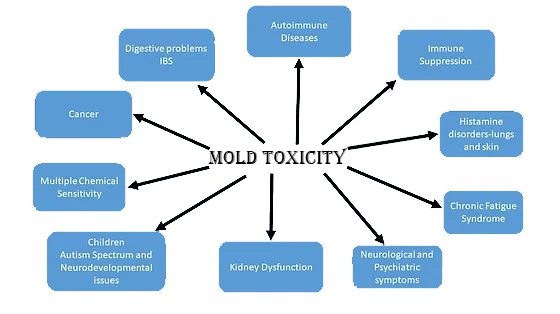Understanding Mold Exposure
Mold exposure can occur silently, hidden behind your walls, or under floorboards. Mold thrives in damp conditions and can proliferate after water damage, turning your home into a potential health risk zone. These microorganisms, known as mold spores, are tiny enough to be inhaled, leading to various health issues.

Hidden danger: Mold growing unseen in damp conditions.
Infiltration of Mold Spores
When mold grows, it releases spores, microscopic particles that float around in the air. If inhaled, these mold spores can lead to several health problems, particularly in individuals with compromised immune systems. The range of symptoms is wide and varied, and mold exposure may not always lead to immediate symptoms.
Common Sites for Mold Growth
Mold is not choosy about where it grows. From your ceiling tiles to your basement, any place with high levels of moisture can become a breeding ground. Commonly, bathrooms, kitchens, and basements are at high risk. Remember, it is essential to prevent mold from taking over your space to maintain a healthy home environment.

Bathrooms are one of the most common sites for mold growth.
What Mold Causes
One of the most deceptive aspects of mold exposure is its wide array of symptoms. It can lead to physical discomfort, as well as mental and emotional distress.
Physical Mold Problem
Mold can cause a variety of physical symptoms. These range from allergic reactions, such as sneezing, eye irritation, and difficulty breathing, to more severe symptoms such as memory loss in cases of prolonged exposure.
- Sneezing and nasal congestion
- Skin rash
- Eye irritation
- Wheezing shortness of breath
- Memory loss
- Compromised immune system
Mental and Emotional Symptoms
There’s increasing evidence that the exposure might affect not just physical health, but mental health too. Symptoms like confusion, anxiety, and depression have been reported among those exposed for long periods.
- Anxiety
- Depression
- Confusion
- Difficulty concentrating
Dangers of Ignoring Mold Symptoms In Home
Ignoring the signs can lead to chronic health problems. These problems can range from chronic allergies to serious health conditions like multiple sclerosis and breast cancer.
what are the side effects of mold Long-Term
The dangers exposed to mold go beyond immediate symptoms. In the long term, exposure can lead to severe respiratory diseases and compromise the immune system’s functionality, leading to more frequent illnesses.

Risks of Ingesting Mold
what happens if you eat mold or drink mold? this isn’t just unpleasant—it can also cause health issues. Ingesting mold may lead to nausea, vomiting, and in severe cases, liver damage due to mycotoxins.
Mold Exposure in Different Areas of the Home
Symptoms can differ based on the area of the home that is infested. For instance, mold in your bathroom could lead to different symptoms than mold in your kitchen due to different types of mold that prefer various environments.
How to Confirm That You Exposed To Mold
If you’ve experienced any allergy symptoms or have noticed signs of mold in your house, it’s essential to seek professional help. Proper diagnosis can help address the problem effectively and prevent further health issues.
Mold Remediation: Importance of Professional Involvement
When it comes to mold removal, it’s crucial to call in professionals. Incorrect removal can not only fail to solve the problem, but it can also potentially make the situation worse by spreading the spores further.
Why Call The Duct Kings for Mold Remediation Services?
If you or your family are experiencing symptoms of mold exposure, don’t hesitate to reach out to professionals for help. It’s crucial to rely on expert control and prevention companies, like The Duct Kings mold remediation services, to efficiently and effectively rid your home of mold.
Conclusion
The risks associated with black mold exposure are real and serious. It’s essential to recognize the symptoms, understand the dangers, and take immediate action. Remember, professional mold removal is the safest and most effective way to deal with mold problems in your home.

When dealing with mold, professional help is essential.
Common Questions
- What are the side effects of breathing mold? Breathing mold can cause a variety of health problems, such as coughing, wheezing, nasal congestion, sore throat, eye irritation, and in severe cases, respiratory issues like asthma.
- What are the side effects of ingesting mold? Ingesting mold can result in nausea, vomiting, diarrhea, and other digestive problems. In some cases, it can also lead to allergic reactions and immune system issues.
- What are the side effects of eating mold? Eating moldy food can cause food poisoning-like symptoms, including abdominal pain, cramps, nausea, vomiting, and diarrhea. Some molds can also produce mycotoxins, potentially leading to more serious health issues. Click here to know more about what happens if you accidentally eat mold.
- What are the side effects of drinking mold? Drinking liquids contaminated with mold can result in digestive issues such as nausea, vomiting, and diarrhea. Long-term consumption might lead to more severe health problems, depending on the type of mold ingested.
